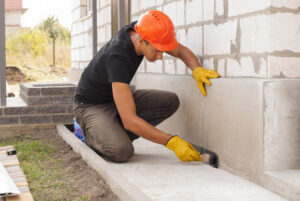Landscaping involves the art of designing and constructing outdoor spaces. The objective is to improve the appearance of an area and increase its usability. It also promotes the preservation of natural resources.

Some companies offer a guarantee, which can be helpful for customers with issues that may arise during a landscaping project. The terms and conditions vary, though. Contact Landscapers Fayetteville AR for professional help.
Using sustainable landscaping practices, such as natural fertilizers and compost instead of synthetic ones, reducing the size of traditional grass lawns and choosing ground cover alternatives, avoiding electric tools, protecting trees and planting native species that attract birds and other pollinators can turn your yard into a mini-ecosystem, benefiting local wildlife. Trees absorb carbon dioxide and provide shade, lowering air temperatures and regulating the soil’s pH level. They also help control noise pollution and create natural privacy around your property.
A healthy, well-maintained landscape is not only environmentally friendly but aesthetically appealing, as it supports your physical and mental health by providing a relaxing space for leisure activities. Spending time in green spaces reduces stress and depression and helps you to feel more connected to nature.
Incorporating recycled materials in your design is another eco-friendly way to improve your home’s aesthetic and functionality. Reusing bricks and stones, for example, can be used to build paths or retaining walls, while recycled glass and plastic can add decorative edging to your garden. Using fly ash concrete, which is made from byproducts of coal combustion, in your projects reduces the use of virgin cement, further minimizing the environmental footprint.
Maintaining healthy soil is a crucial aspect of environmental friendly landscaping, as it promotes plant growth and fosters a vibrant ecosystem. It is important to choose native plants and avoid the use of chemical fertilizers, herbicides and pesticides as they deplete soil nutrients over time and are harmful to local wildlife. Adding organic matter, such as compost, to your soil helps improve its structure and nutrient content. Incorporating stormwater management techniques, like bioswales, into your landscape can significantly reduce runoff and prevent soil erosion.
Adds Value to Your Home
A beautiful, well-maintained landscape adds value to your home, increasing the chances of a quick sale. This is a great option for homeowners who want to increase the curb appeal of their homes without spending a lot of money on a new paint job or a roof replacement.
Landscaping services are available in two different forms: softscape and hardscape. Softscape includes flowers, grasses, trees, and shrubs. It can also include pathways, retaining walls, and decorative stone elements. Hardscape is made up of features such as patios, decks, and porches. A skilled landscaping company will consider all the features of a home and design the best way to complement them with the surrounding environment.
Many studies have shown that landscaping increases property values and is a good return on investment for homeowners. Homeowners typically recoup about 83 percent of the cost of outdoor hardscaping and can expect to see a boost in their home’s value of up to 30 percent.
Experts recommend choosing plants that are native to your climate, as they will thrive in your region’s weather conditions and require less maintenance than exotic species. In addition, strategically planting trees and bushes will provide shade in the summer, lowering energy bills. Adding water structures such as a pond or fountain will create ambiance and be a focal point of the yard, increasing beauty. Lastly, adding outdoor lighting will ensure that walkways and seating areas are illuminated so guests can safely navigate the property at night.
A tidied up yard will attract the eye of potential buyers and make a lasting impression on them. Landscaping is one of the few home improvements that continue to grow in value over time, unlike most other renovations.
Reduces Stress
Studies show that being in nature lowers stress, boosts focus and improves mood. Creating a beautiful garden at home provides a daily escape from the noise and chaos of modern life. Gardening and other outdoor maintenance tasks also provide low-impact, full-body exercise, which improves cardiovascular health.
Using layers of plants to create depth and interest, incorporating curves rather than straight lines and adding natural elements like water or stone help a landscape feel more peaceful and organic. The color and texture of different elements in a landscape should complement one another to create harmony and balance. For example, a pond or waterfall adds movement and sound while rocks, statues and lanterns can create visual intrigue and symbolism.
Plants and trees reduce air pollution by absorbing carbon dioxide and producing oxygen. They can also minimize the heat on your property during summers and improve drainage to prevent erosion. Landscapes also serve as natural barriers that block unwanted views from neighbors and roads. Landscaping can also include a variety of trees and shrubs that provide shade to keep your house cool, and strategically planted windbreaks protect your yard from the wind.
Regularly tending your garden is a form of low-impact, full-body exercise that improves cardiovascular health and increases physical strength. It can also reduce depression, anxiety and feelings of loneliness. Gardening is a great way to get your hands in the dirt and feel a sense of accomplishment from starting seeds and watching them grow into luscious plants. Plus, a well-maintained garden is safer for walking and provides a deterrent to burglars by making the yard more visible. A properly maintained landscape can increase the value of your home, make it more functional and enjoyable for relaxing or entertaining guests, and improve the overall quality of life for homeowners and their families.
Reduces Noise Pollution
Many homeowners live close to busy roads or in densely populated neighborhoods where traffic noise is a constant source of irritation. The good news is that effective landscaping solutions can reduce the nuisance of noisy traffic and other outdoor noises without compromising your yard’s beauty.
Noise-reducing landscaping strategies include the use of berms (raised mounds of earth) and dense plantings that offer sound-absorbing properties. Using these natural solutions in conjunction with hardscape elements like walls and fences can help block out unwanted sounds while creating an elegantly designed landscape.
The best way to block out unwanted noises is to create a barrier that separates your living space from the source of the disturbance. For maximum effectiveness, the barrier should obstruct the line of sight between your home and the sound source as much as possible. This can be accomplished by placing a wall between your property and the nearest sound-producing source, building a high-walled garden enclosure that blocks out noises, or installing large, densely-planted shrubbery that effectively muffles intrusive sounds.
Dense evergreen trees and shrubs offer a natural sound barrier that softens the roar of highway traffic, neighborhood children’s play, or neighbors’ parties. When planted in layers, these plants can also provide privacy and a sense of calm to your backyard.
If you’re interested in incorporating noise-reducing trees and shrubs into your landscape, it’s important to select species that are resilient and adaptable to your climate. Fast-growing shrubs and trees that can tolerate harsh weather conditions, such as hedging varieties like lonicera tatarica and Privet ulmus ‘Purple’ or evergreens such as Cupressocyparis leylandii, are ideal. Regular maintenance is also necessary to keep these plants in top condition and performing their best.
Creates a Mini-Ecosystem
A beautiful landscape creates a mini-ecosystem for native plants, animals and pollinators. It also reduces soil erosion and provides shelter and food for wildlife. It is not only good for the environment but it is also relaxing and mentally stimulating to spend time in a well-designed outdoor space. Landscaping also boosts property value and makes your home more enjoyable.
Sustainable landscaping is a new trend in gardening that is gaining popularity as it reduces the use of chemicals and other harmful substances. The idea is to work with nature rather than trying to outsmart it. Native plants are better for the environment as they are built for Massachusetts weather and soil. They require less watering and help keep the ecosystem balanced.
If you are looking to add a natural touch to your home, you may want to consider creating an ecosystem in a jar. This trend is popular on TikTok and involves combining moss, rocks, soil, plants, and other living elements into a aesthetically pleasing decor piece that can be placed in the window.
A clear glass container is ideal for these eco-systems, as it allows you to see the progression of the plants over time. In addition, water condenses easily on glass, making it easier for your closed system to stay hydrated. The moss is an important part of any ecosystem in a jar as it provides the nutrients that other plants need to thrive.
The final step is adding a layer of soil, preferably one that does not contain too much sand. This will give the plants something to hold onto and allow them to grow taller. A few stones can be added to the mix to provide some texture and interest. It is recommended that you place your closed ecosystem in a sunny spot so it can receive sunlight for photosynthesis.



